 |
| January 06, 2015 | Volume 11 Issue 01 |
Materials News & Products
Designfax weekly eMagazine
Archives
Partners
Manufacturing Center
Product Spotlight
Modern Applications News
Metalworking Ideas For
Today's Job Shops
Tooling and Production
Strategies for large
metalworking plants
Engineering challenge: Which 3D-printed parts will fade?
 How does prolonged exposure to intense UV light impact 3D-printed plastics? Will they fade? This is what Xometry's Director of Application Engineering, Greg Paulsen, set to find out. In this video, Paulsen performs comprehensive tests on samples manufactured using various additive processes, including FDM, SLS, SLA, PolyJet, DLS, and LSPc, to determine their UV resistance. Very informative. Some results may surprise you.
How does prolonged exposure to intense UV light impact 3D-printed plastics? Will they fade? This is what Xometry's Director of Application Engineering, Greg Paulsen, set to find out. In this video, Paulsen performs comprehensive tests on samples manufactured using various additive processes, including FDM, SLS, SLA, PolyJet, DLS, and LSPc, to determine their UV resistance. Very informative. Some results may surprise you.
View the video.
Copper filament for 3D printing
 Virtual Foundry, the company that brought us 3D-printable lunar regolith simulant, says its popular Copper Filamet™ (not a typo) is "back in stock and ready for your next project." This material is compatible with any open-architecture FDM/FFF 3D printer. After sintering, final parts are 100% pure copper. Also available as pellets. The company says this is one of the easiest materials to print and sinter. New Porcelain Filamet™ available too.
Virtual Foundry, the company that brought us 3D-printable lunar regolith simulant, says its popular Copper Filamet™ (not a typo) is "back in stock and ready for your next project." This material is compatible with any open-architecture FDM/FFF 3D printer. After sintering, final parts are 100% pure copper. Also available as pellets. The company says this is one of the easiest materials to print and sinter. New Porcelain Filamet™ available too.
Learn more and get all the specs.
Copper foam -- so many advantages
 Copper foam from Goodfellow combines the outstanding thermal conductivity of copper with the structural benefits of a metal foam. These features are of particular interest to design engineers working in the fields of medical products and devices, defense systems and manned flight, power generation, and the manufacture of semiconductor devices. This product has a true skeletal structure with no voids, inclusions, or entrapments. A perennial favorite of Designfax readers.
Copper foam from Goodfellow combines the outstanding thermal conductivity of copper with the structural benefits of a metal foam. These features are of particular interest to design engineers working in the fields of medical products and devices, defense systems and manned flight, power generation, and the manufacture of semiconductor devices. This product has a true skeletal structure with no voids, inclusions, or entrapments. A perennial favorite of Designfax readers.
Learn more.
When glass or plastic can't cut it: Transparent ceramics solve critical design challenges
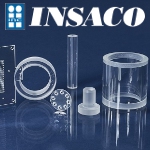 Complex designs are still possible when grinding and polishing Fused Silica or Sapphire. Ceramic properties such as wear, abrasion resistance, and strength of these optical materials can be a designer's dream solution when high temperatures or severe environments rule out standard optical glass or plastic. INSACO is a machine shop specializing in ultra-hard and extreme materials.
Complex designs are still possible when grinding and polishing Fused Silica or Sapphire. Ceramic properties such as wear, abrasion resistance, and strength of these optical materials can be a designer's dream solution when high temperatures or severe environments rule out standard optical glass or plastic. INSACO is a machine shop specializing in ultra-hard and extreme materials.
→ Contact Jackson Evans, Sales Engineer at INSACO jpe@insaco.com.
→ Learn more about INSACO materials and capabilities.
New aero and defense PEKK-based FDM polymers from Stratasys
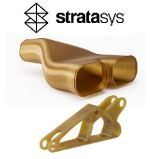 Stratasys has partnered with top aerospace and defense companies to develop two newly qualified materials for 3D printing. Antero 800NA is a PEKK-based FDM polymer with excellent physical and mechanical properties for demanding applications. Antero 840CN03 is a high-performance PEKK-based FDM polymer with electrostatic dissipative (ESD) properties. These new advanced industrial solution materials were rigorously qualified in collaboration with Northrop Grumman, Boeing, Blue Origin, Raytheon, Naval Air Systems Command, the National Institute for Aviation Research, United States Air Force, BAE, and Stratasys Direct Manufacturing.
Stratasys has partnered with top aerospace and defense companies to develop two newly qualified materials for 3D printing. Antero 800NA is a PEKK-based FDM polymer with excellent physical and mechanical properties for demanding applications. Antero 840CN03 is a high-performance PEKK-based FDM polymer with electrostatic dissipative (ESD) properties. These new advanced industrial solution materials were rigorously qualified in collaboration with Northrop Grumman, Boeing, Blue Origin, Raytheon, Naval Air Systems Command, the National Institute for Aviation Research, United States Air Force, BAE, and Stratasys Direct Manufacturing.
Learn more.
EOS expands its Nickel superalloys for 3D printing
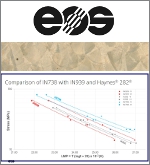 EOS, a leading supplier of manufacturing solutions for industrial 3D printing, has added two new metal additive manufacturing materials: EOS NickelAlloy IN738 and EOS NickelAlloy K500, both delivering excellent performance, part properties, and value to a variety of industries that leverage EOS Laser Powder Bed Fusion (LBPF) 3D-printing technology. The IN738 superalloy is aimed at high-strength, high-stress energy and turbomachinery applications, while the K500 superalloy is a cost-effective, corrosion-resistant option for chemical, maritime, and space industries.
EOS, a leading supplier of manufacturing solutions for industrial 3D printing, has added two new metal additive manufacturing materials: EOS NickelAlloy IN738 and EOS NickelAlloy K500, both delivering excellent performance, part properties, and value to a variety of industries that leverage EOS Laser Powder Bed Fusion (LBPF) 3D-printing technology. The IN738 superalloy is aimed at high-strength, high-stress energy and turbomachinery applications, while the K500 superalloy is a cost-effective, corrosion-resistant option for chemical, maritime, and space industries.
Learn more.
CNC machining: How to avoid high costs on thin walls
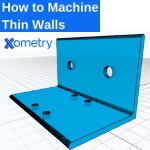 Parts that are light and strong are crucial to nearly every industry. To achieve better performance without risking part failure, parts must maintain a specific wall-height-to-thickness ratio and wall-height-to-length ratio. Additionally, some geometries and supports can support thin walls to achieve a lighter component weight. Dive deeper into the cost drivers behind CNC-machined thin walls in this Xometry design-for-manufacturing article.
Parts that are light and strong are crucial to nearly every industry. To achieve better performance without risking part failure, parts must maintain a specific wall-height-to-thickness ratio and wall-height-to-length ratio. Additionally, some geometries and supports can support thin walls to achieve a lighter component weight. Dive deeper into the cost drivers behind CNC-machined thin walls in this Xometry design-for-manufacturing article.
Read the full article.
Eco-friendly thermoplastic: Light, rigid, strong, damping
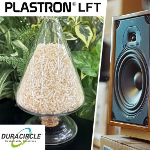 Polyplastics has launched PLASTRON® LFT (Long Fiber-Reinforced Thermoplastic) RA627P, an eco-friendly composite of polypropylene (PP) resin and long cellulose fiber that delivers low density, high specific rigidity, high impact strength, and excellent damping for a range of applications including audio components and housings of industrial components. LFT exhibits 10% lower density than 30% short glass fiber-reinforced PP resin, roughly the same flexural modulus, and a specific rigidity that is higher.
Polyplastics has launched PLASTRON® LFT (Long Fiber-Reinforced Thermoplastic) RA627P, an eco-friendly composite of polypropylene (PP) resin and long cellulose fiber that delivers low density, high specific rigidity, high impact strength, and excellent damping for a range of applications including audio components and housings of industrial components. LFT exhibits 10% lower density than 30% short glass fiber-reinforced PP resin, roughly the same flexural modulus, and a specific rigidity that is higher.
Learn more.
Sound-dampening foam with an eco edge
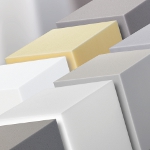 BASF has introduced Basotect® EcoBalanced melamine foam, a material that helps to reduce the product carbon footprint (PCF) of many sound-absorption applications in the transportation, building, and construction industries. This easy, drop-in solution has an up to 50% lower PCF than the respective BASF standard grades but demonstrates the same material performance. Applications include engine covers, wall and ceiling sound absorbers, HVAC parts, and air cleaners.
BASF has introduced Basotect® EcoBalanced melamine foam, a material that helps to reduce the product carbon footprint (PCF) of many sound-absorption applications in the transportation, building, and construction industries. This easy, drop-in solution has an up to 50% lower PCF than the respective BASF standard grades but demonstrates the same material performance. Applications include engine covers, wall and ceiling sound absorbers, HVAC parts, and air cleaners.
Learn more.
Fastest large-format SLA 3D printer in the world
 Built on Formlabs' next-generation Low Force Display print engine, the new Form 4L SLA 3D printer delivers unmatched reliability with a 99% print success rate compared to other SLA 3D printers. These benefits, combined with a build volume nearly 5x the size of Form 4, allow Form 4L users to solve big problems and print smaller parts at high volume. Large-scale prints finished in under six hours.
Built on Formlabs' next-generation Low Force Display print engine, the new Form 4L SLA 3D printer delivers unmatched reliability with a 99% print success rate compared to other SLA 3D printers. These benefits, combined with a build volume nearly 5x the size of Form 4, allow Form 4L users to solve big problems and print smaller parts at high volume. Large-scale prints finished in under six hours.
Learn more.
Keypad teardown and design insights with Autodesk and Xometry
 Take a deep dive into the second revision of the macro keypad developed for Autodesk University's Factory Experience 2024 in this exclusive, on-demand webinar hosted by Xometry's Greg Paulsen and Autodesk Fusion's Jonathan Odom. This presentation features a live teardown of the keypad, showcasing how the design team addressed challenges and elevated the product. No registration required.
Take a deep dive into the second revision of the macro keypad developed for Autodesk University's Factory Experience 2024 in this exclusive, on-demand webinar hosted by Xometry's Greg Paulsen and Autodesk Fusion's Jonathan Odom. This presentation features a live teardown of the keypad, showcasing how the design team addressed challenges and elevated the product. No registration required.
Watch this Xometry webinar at your convenience.
Tube cutting and bending design guide: Xometry
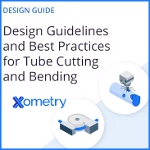 Xometry's no-cost tube design guide offers design tips and tricks for laser-cut tube parts, including: minimums, tolerances, and sizes. The guide also covers important rules for mandrel tube bending, such as tolerancing, distance between bends, bend center line radius, types of bends to avoid, and more. Incredibly handy. If you need parts, Xometry can help with that too. It's easy to get a quote.
Xometry's no-cost tube design guide offers design tips and tricks for laser-cut tube parts, including: minimums, tolerances, and sizes. The guide also covers important rules for mandrel tube bending, such as tolerancing, distance between bends, bend center line radius, types of bends to avoid, and more. Incredibly handy. If you need parts, Xometry can help with that too. It's easy to get a quote.
Learn more.
SPEE3D develops ultra-corrosion-resistant alloy
-- a game-changer for maritime additive manufacturing
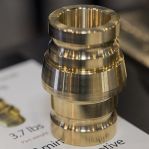 Australian manufacturer SPEE3D has developed two grades of an ultra-corrosion-resistant Nickel Aluminum Bronze alloy that are compatible with its Cold Spray Additive Manufacturing technology. The powder material is a game-changer for maritime OEMs and the U.S. Navy, as it will help with supply chain delays and keep critical maritime systems operational.
Australian manufacturer SPEE3D has developed two grades of an ultra-corrosion-resistant Nickel Aluminum Bronze alloy that are compatible with its Cold Spray Additive Manufacturing technology. The powder material is a game-changer for maritime OEMs and the U.S. Navy, as it will help with supply chain delays and keep critical maritime systems operational.
Read the full article.
New polymer bearings are PFAS- and PTFE-free
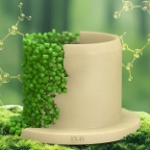 igus has developed a new polymer bearing material called iglide JPF that is free of both per- and polyfluoroalkyl substances (PFAS) and polytetrafluoroethylene (PTFE). This innovation marks an important step in the company's efforts to create sustainable alternatives to conventional plain bearings. JPF is a dry-running, wear-resistant polymer that offers comparable friction and wear performance to iglide J. It delivers high wear resistance and durability.
igus has developed a new polymer bearing material called iglide JPF that is free of both per- and polyfluoroalkyl substances (PFAS) and polytetrafluoroethylene (PTFE). This innovation marks an important step in the company's efforts to create sustainable alternatives to conventional plain bearings. JPF is a dry-running, wear-resistant polymer that offers comparable friction and wear performance to iglide J. It delivers high wear resistance and durability.
Learn more.
New high-speed PSLA 270 printer from 3D Systems
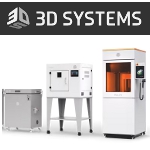 The all-new PSLA 270 projector-based polymer 3D-printing platform and associated new materials from 3D Systems enable faster production times for a wide range of applications. This machine's high throughput and accuracy make it ideal for industries like healthcare, aerospace, automotive, and manufacturing, where precise and durable components are critical. Complementary Wash and Cure systems streamline post-processing and ensure high-quality finished parts.
The all-new PSLA 270 projector-based polymer 3D-printing platform and associated new materials from 3D Systems enable faster production times for a wide range of applications. This machine's high throughput and accuracy make it ideal for industries like healthcare, aerospace, automotive, and manufacturing, where precise and durable components are critical. Complementary Wash and Cure systems streamline post-processing and ensure high-quality finished parts.
Learn more including materials and build sizes.
Ditch the magnets: Tabletop motor with electrostatic drive developed at UW-Madison
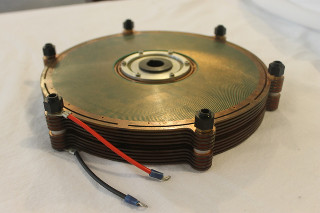
A prototype electric motor that uses a new principle for transforming electricity into rotary force is being developed at C-Motive Technologies, a company co-founded by UW-Madison assistant professor Dan Ludois. [Photo: Dan Ludois]
By David Tenenbaum, UW-Madison
A tabletop motor using an entirely new driving principle is under development at the headquarters of C-Motive Technologies, a startup business that is commercializing technology from the College of Engineering at UW-Madison.
"We have proven the concept of a new motor that uses electric fields rather than magnetic fields to transform electricity into a rotary force," says company co-founder Dan Ludois, an assistant professor of electrical and computer engineering at the UW. The distinction may sound minor, but it could solve a number of practical problems while saving money, he explains.
Actually, the concept is not entirely new: Benjamin Franklin and others described and built motors based on electrostatic forces back in the 18th and 19th centuries, but none achieved practical operation. Since the widespread adoption of electric motors a century ago, magnetism has been the only practical source of rotation. Magnetism is easier to exploit than electrostatic fields due to the properties of naturally occurring materials and simple engineering techniques. However, new advances in materials, mechanical engineering, and advanced manufacturing may enable electrostatic motors.
In 2011, while Ludois was finishing a Ph.D. thesis at UW-Madison, he realized that instead of relying on magnetic fields, he could achieve a similar result by manipulating electric fields to create a motor based on electrostatic attraction. The new technique, he realized, could deliver major advantages in weight, material cost, operating efficiency, and maintenance requirements.
In the motor on display, nested stationary and rotating plates are held hairs-width apart by a unique air-cushioning strategy. An electric voltage delivered to the fixed plates creates an electrostatic field that attracts the rotating plates in a way that forces them to spin.
"A charge builds up on the surfaces of the plates, and if you can manipulate the charge, you can convert electricity into rotary motion or transfer electric power from one set of plates to the other," says Ludois.
This type of coupling can be used "to power things that move without touching," Ludois adds.
The breakthrough relies on electronics that precisely control a high-voltage, high-frequency electric field and fluid mechanics to keep the surfaces close without touching. "Nothing is touching, because you are using electric fields to couple the stationary and rotating parts," Ludois says. "There is no contact, and no maintenance.
"Rather than magnetism, we are using the force that holds your clothes together when you take them out of the drier: electrostatic force. This technique can power anything that needs to move, and that you don't want to touch while it's moving."
Because motors and generators are essentially mirror images of each other, the invention may first meet the market in the form of a generator for wind turbines, an application for which C-Motive Technologies received a Small Business Innovation Research grant for development and research from the National Science Foundation in 2014.
By saving weight and materials, and boosting efficiency, the new design should give the company a bottom-line advantage. The new design avoids the use of precious "rare earth" metals and substitutes aluminum for the more expensive copper found in magnet windings of conventional motors and generators.
When C-Motive was founded, Ludois and co-founders Justin Reed and Micah Erickson were all Ph.D. students. "It's really hard to beat the world, especially when you start out as three graduate students," Ludois says.
C-Motive has had its share of help from UW-Madison. Two years ago, the idea won two awards in the G. Steven Burrill Business Plan Competition, run through the Wisconsin School of Business. C-Motive has also received $100,000 in seed funding from the Weinert Applied Ventures in Entrepreneurship course, another School of Business resource.
In 2011, the Wisconsin Alumni Research Foundation supported Ludois and his colleagues for patent protection on the discovery, giving them the leverage to pursue additional funding. After six months in the Metro Innovation Center on East Washington Avenue, C-Motive is now housed in an office/lab space near Stoughton Road in Madison to house its five full-time employees, including two of the three founders.
Published September 2014
Rate this article
View our terms of use and privacy policy
